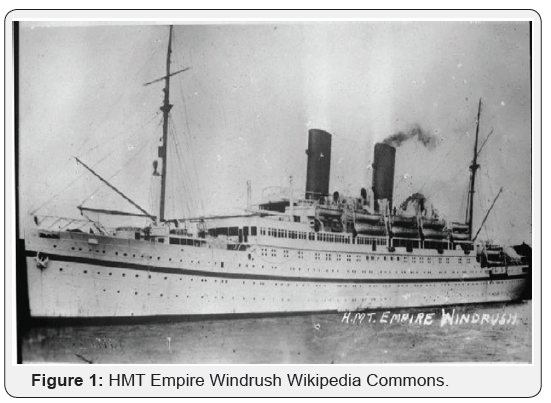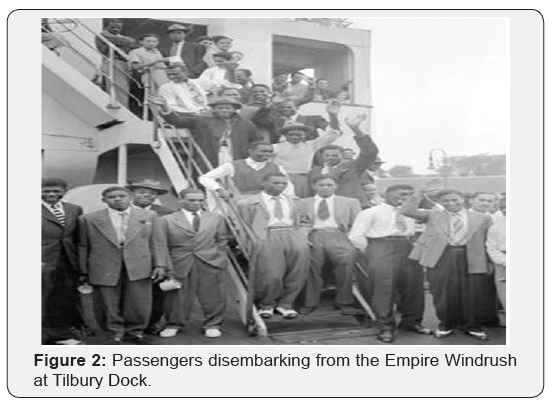Generation Windrush: diasporic landscapes and settlement-Juniper Publishers
Archaeology & Anthropology- Juniper Publishers
The Windrush scandal
In April 2018, the British government faced
widespread public anger and outcry against, and later acknowledged, the
mistreatment of hundreds of British Caribbean residents who had settled
in the United Kingdom following the Second World War [1]. Migrants from
the then British colonies in the Caribbean had been encouraged to cross
the Atlantic by the British government and industriesand were offered
work permits to help re-build an economy and society decimated by war.
West Indian migrants arriving between 1948 and the early 1970s came to
be known as the ‘Windrush Generation’, named after the first 492 adults
and children arriving from Jamaica, who disembarked from the passenger
ship HMT Empire Windrush at Tilbury Docks, London on 22ndJune1948.

Migrants and settlers from Caribbean societies have
shaped British history and society for centuries, and the transatlantic
Caribbean diaspora has been built up via layered and interwoven social,
cultural, economic and political landscapes of connection
and subtle divergence [2]. The Windrush Generation’s contributions to
the multiculturalism of British life today have been formative and
striking [3,4]. Windrush writers and artists, such as Sam Selvon &
Linton Kwesi Johnson [5,6]- LKJ - have themselves generated a
substantial oeuvre of Black British writing and cultural energy that
lies as much at the heart of British society, as do the economic
contributions of the early Windrush migrant workers and subsequent
generations. Since many children arrived and settled in the United
Kingdom legally via their parents’ passports, the exact number of the
Windrush Generation is not clear, but it amounts to thousands,
reinforcing the quantitative and qualitative Caribbean underpinnings of
British society today(Figure 1).

Given that such deep and positive influences of the
Windrush Generation are widely celebrated, it seemed all
the more outrageous and perplexing that since 2012, the British
government’s ‘hostile environment’ policy has created great insecurity
and uncertainty among many lawful British
Caribbean residents. This antagonistic agenda constituted a set
of administrative and legislative measures designed to make
staying in the United Kingdom more difficult for residents without
full citizenship, even if they were entitled to such rights(Figure
2). This proved to be the case for many Windrush settlers and
their children, who have faced restricted access to welfare
services, internship, and actual or threatened deportation back
to the Caribbean, even after five decades of legal residence in the
United Kingdom.
Just as writers and artists such as LKJ and Selvon have
relayed the hardships of arriving and living in Britain during
the Windrush era, and riled at ongoing legacies of empire
and slavery, the current targets of this only recently revoked
crackdown - May 2018 - are now making their own political
and cultural voices heard. New oral and visual diasporic
landscapes of resistance and cries for justice are being formed.
This live topography reflects longstanding tensions of diasporic
landscapes experienced by earlier migrants crossing the Atlantic
in the reverse direction from Britain. Those stressed are felt in
the need to create a new sense of dwelling and self in strange
lands by making fresh pathways, generating mobile identities,
while also collating past memories and seeking stasis and
settlement in place.
Diaspora, mobility and settlement
Disaporic landscapes explore the intimacies between
body and place that mobility continues to create, reflecting
spatial scales of embodiment, while highlighting intersections
of complex identities with diverse historical and physical
trajectories. These embodied landscapes underpin experiences
of migration and settlement, reflecting closely Machado’s
understanding that individual and collective diasporas are rarely
pre-determined, always in motion - ‘there is no road, the road is
made by walking’:
Caminante, son tus huellas
el camino, y nada más;
caminante, no hay camino,
se hace camino al andar.
Al andar se hace camino,
y al volver la vista atrás
se ve la senda que nunca
se ha de volver a pisar.
Machado’s serial optimism of re-creation and progressive
enlightenment through movement runs counter to more
pessimistic or stressed contexts and accounts of diaspora
formation and memory. Such tensions are reflected in twentieth
and twenty-first century-transatlantic diasporic writings, as
well as many before, en route from Britain to North America.
Robert Louis Stevenson’s experiences as an emigrant to the
United States reflect the more downbeat context of mobility
that can shape sombre realisations and intimacies of footfall
and motion, through troubling or troubled landscapes. While
voyaging across the Atlantic, Stevenson’s thoughts were not of
an open future, but of a lost past and curtailed present: ‘… all
now belonging for ten days to one small iron country on the
deep. We were a company of the rejected… We were a shipful
of failures, the broken men of England’. The historical intimacy
of his Scottish ancestry is subsumed into the hard, momentary
present of a ship’s metal hulk. For Stevenson and many others,
the flight from home, albeit to build another, was not youthful
and full of hope, but engendered a desperate and despondent
setting. Acquaintances were scraped together, rather than
friendships forged. These intimacies of knowledge and
experience, generated by movement, embodied as much distance
as proximity; exclusion and inclusion shared in uneven doses.
A century beforehand, Johnson [7] had referred to the making
of this new Scottish diaspora in the Americas as a dilution of
energy, a loss of heat from a waning national hearth: …for a
nation scattered in the boundless regions of America resembles
rays diverging from a focus. All the rays remain, but the heat is
gone. Their power consisted in their concentration: when they
dispersed, they have no effect. It may be thought that they are
happier by the change; but they are not happy as a nation, for
they are a nation no longer… they must want that security, that
dignity, that happiness, whatever it be, which a prosperous
community throws back upon individuals(Figure 3).

Traumatic tensions of optimism and pessimism, celebratory
recollection and solemn commemoration of place, person
and movement are revealed. Transdisciplinary approaches to
memory, mobility and mindsets reflect Bergson’s [8] thesis on
spontaneous (la mémoire spontanée) and voluntary (la mémoire
volontaire) processes of recollection. While time, he suggests
runs with a linear, irreversible current, the embodiment of
human memory transcends both time and space. The migrant
and settler’s memory acts vertically, as fleeting, unexpected
glimpses of the past and future that cut across and into present
constructions of place and senses of belonging. Human memory unites past and present in one place, joining or displacing the
individual or collective in the context of the moment and with
intimate depths of human experience, knowledge and identity.
The experiences of ‘Generation Windrush’ are many miles
and eras way from the writing of these two, now celebrated,
Scottish writers. Connections, however, may be found in charting
a series of pathways through visceral and emotive landscapes,
offering the reader and writer a series of routes by which
to figure out diverse memories and narratives of diasporic
identities. The process of creating a path to a place generates the
disaporic landscapes revealed historically and today, and which
are emerging now in poignant new political and cultural forms
as British society as whole comes to terms with the woefully
misguided notion of a ‘hostile environment’. ‘Landscape’ is often
understood as a noun connoting fixity, yet diasporic literature
reveals the word as a ‘hidden verb’:the landscapes are dynamic
and cause commotion; they are ‘bristling’ with identities,
memories and the transformative effects of moving through
place[9-12].



Comments
Post a Comment